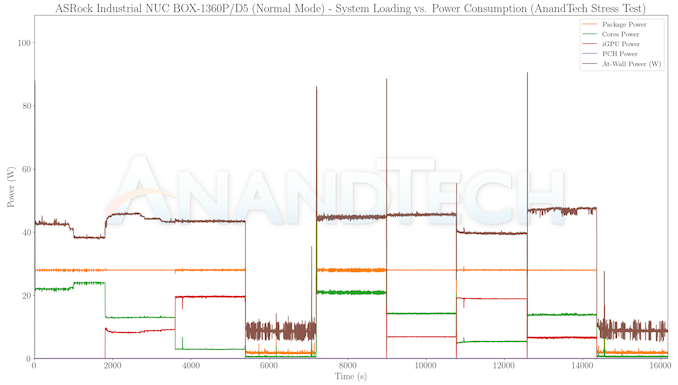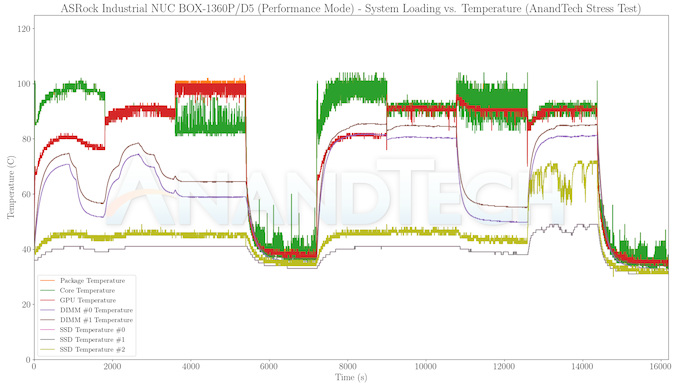ASRock Industrial NUC BOX-1360P/D5 Review: Raptor Lake-P on the Leading Edge
by Ganesh T S on July 18, 2023 10:30 AM EST- Posted in
- Systems
- Intel
- UCFF
- Mini-PC
- ASRock Industrial
- Raptor Lake-P
Power Consumption and Thermal Characteristics
The power consumption at the wall was measured with a 4K display being driven through the HDMI port of the system. In the graph below, we compare the idle and load power of the ASRock NUC BOX-1360P/D5 with other systems evaluated before. For load power consumption, we ran the AIDA64 System Stability Test with various stress components, as well as our custom stress test with Prime95 / Furmark, and noted the peak as well as idling power consumption at the wall.

The numbers are consistent with the TDP and suggested PL1 / PL2 values for the processors in the systems, and do not come as any surprise. We are glad that ASRock Industrial has finally addressed the idle power consumption numbers issue that had been plaguing their NUC BOX systems since Tiger Lake. At 5.19W idling, only the Arena Canyon and Wall Street Canyon NUCs have better numbers. The higher peak number for Arena Canyon NUC shows that it can possibly outperform the NUC BOX-1360P/D5 in performance mode for specific short-burst workloads.
Stress Testing
Our thermal stress routine is a combination of Prime95, Furmark, and Finalwire's AIDA64 System Stability Test. The following 9-step sequence is followed, starting with the system at idle:
- Start with the Prime95 stress test configured for maximum power consumption
- After 30 minutes, add Furmark GPU stress workload
- After 30 minutes, terminate the Prime95 workload
- After 30 minutes, terminate the Furmark workload and let the system idle
- After 30 minutes of idling, start the AIDA64 System Stress Test (SST) with CPU, caches, and RAM activated
- After 30 minutes, terminate the previous AIDA64 SST and start a new one with the GPU, CPU, caches, and RAM activated
- After 30 minutes, terminate the previous AIDA64 SST and start a new one with only the GPU activated
- After 30 minutes, terminate the previous AIDA64 SST and start a new one with the CPU, GPU, caches, RAM, and SSD activated
- After 30 minutes, terminate the AIDA64 SST and let the system idle for 30 minutes
Traditionally, this test used to record the clock frequencies - however, with the increasing number of cores in modern processors and fine-grained clock control, frequency information makes the graphs cluttered and doesn't contribute much to understanding the thermal performance of the system. The focus is now on the power consumption and temperature profiles to determine if throttling is in play.
The 'Normal Mode' graphs throw no surprise whatsoever. The package power remains constant at 28W during active loading, with the iGPU alone getting a 20W allotment at the maximum. On the temperature front, the CPU package and cores are kept below 85C even under extreme stress. The point of concern is the SSD temperature reaching 75C in the disk stress test segment. This is not particularly good for SSD reliability. ASRock Industrial must endeavour to provide some sort of thermal solution for the SSDs in their mini-PCs.
The power numbers in the 'Performance Mode' graph appear good - 40W sustained package power, with the iGPU getting around 32W. SSD temperatures go high in the disk stress segment, as expected. However, the more worrisome aspect is the core and package temperatures hitting 100C. This is bound to create thermal throttling in the system.














21 Comments
View All Comments
abufrejoval - Monday, July 24, 2023 - link
What irritates me immensely is that AMD NUCs only ever become available with the previous generation APUs (or older yet).With Intel NUCs actually tended to lead with the latest generation chips, sometimes even giving you variants that were hard or impossible to get even as a notebook.
Plenty of people will be quite happy with Cezanne, and that's great as an economical industrial option. But for a bit of extra money, I'd like to be able to get a Zen 4 NUC today, not when Zen 5 is coming out.